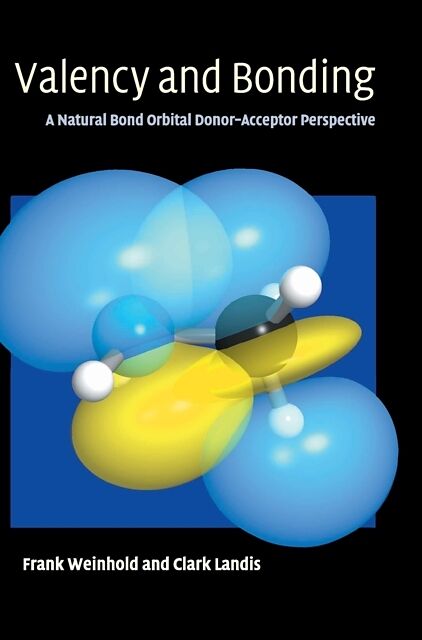Valency and Bonding
Einband:
Fester Einband
EAN:
9780521831284
Untertitel:
A Natural Bond Orbital Donor-Acceptor Perspective
Autor:
Frank Weinhold
Herausgeber:
Cambridge University Press
Anzahl Seiten:
760
Erscheinungsdatum:
01.07.2005
ISBN:
0521831288
The first modernized overview of chemical valency and bonding theory, based on current computational technology.
Klappentext This graduate level text presents the first comprehensive overview of modern chemical valency and bonding theory! written by internationally recognised experts in the field. The authors build on the foundation of Lewis- and Pauling-like localized structural and hybridization concepts to present a book that is directly based on current ab-initio computational technology. The presentation is highly visual and intuitive throughout. Hundreds of orbital illustrations help to convey the essence of modern NBO concepts for those with little background in the mathematical machinery of the Schrödinger equation. Zusammenfassung This graduate level text presents the first comprehensive overview of modern chemical valency and bonding theory! written by internationally recognised experts. The authors build on the foundation of Lewis- and Pauling-like localized structural and hybridization concepts! presenting a book that is directly based on current ab-initio computational technology. Inhaltsverzeichnis Part I. Introduction and Theoretical Background: 1. The Schrödinger equation and models of chemistry; 2. Hydrogen atom orbitals; 3. Many-electron systems; 4. Perturbation theory for orbitals in the Hartree-Fock framework: the donor-acceptor paradigm; 5. Density matrices, natural localized and delocalized orbitals and the Lewis structure picture; 6. Natural resonance structures and weightings; 7. Pauli exchange antisymmetry and steric repulsions; 8. Summary; Part II. Electrostatic and Ionic Bonding: 9. Introduction; 10. Atomic and ionic orbitals; 11. Charge transfer and hybridization changes in ionic bonding; 12. Donor-acceptor theory of hybridization changes in ionic bonding; 13. Ionic/covalent transitions; 14. Ion-dipole and dipole-dipole bonding; 15. Beta ionic compounds of heavy alkaline earths; 16. Ionic bonding in D-block elements; 17. Summary; Part III. Molecular Bonding in the S/P-Block Elements: 18. Introduction; 19. Covalent and polar covalent bonding; 20. Conjugation and aromaticity; 21. Hyperconjugation; 22. Hypervalency; 23. Hypovalency; 24. Summary; Part IV. Molecular Bonding in the D-Block Elements: 25. Introduction; 26. Lewis-like structures for the D-block; 27. Hybridization and molecular shape; 28. Covalent and polar covalent bonding; 29. Coordinative metal-ligand bonding; 30. Hypervalent bonding; 31. Hypovalency and agostic interactions; 32. Conjugative and hyperconjugative effects; 33. Multi-electron coordination; 34. Vertical trends in transition metal bonding; 35. Summary; Part V. Supramolecular Bonding: 36. Introductory overview of intermolecular forces; 37. Hydrogen bonding; 38. Charge transfer complexes; 39. Transition state species; 40. Coupling of intra- and intermolecular interactions; 41. Summary; Appendices....
Inhalt
Part I. Introduction and Theoretical Background: 1. The Schrödinger equation and models of chemistry; 2. Hydrogen atom orbitals; 3. Many-electron systems; 4. Perturbation theory for orbitals in the Hartree-Fock framework: the donor-acceptor paradigm; 5. Density matrices, natural localized and delocalized orbitals and the Lewis structure picture; 6. Natural resonance structures and weightings; 7. Pauli exchange antisymmetry and steric repulsions; 8. Summary; Part II. Electrostatic and Ionic Bonding: 9. Introduction; 10. Atomic and ionic orbitals; 11. Charge transfer and hybridization changes in ionic bonding; 12. Donor-acceptor theory of hybridization changes in ionic bonding; 13. Ionic/covalent transitions; 14. Ion-dipole and dipole-dipole bonding; 15. Beta ionic compounds of heavy alkaline earths; 16. Ionic bonding in D-block elements; 17. Summary; Part III. Molecular Bonding in the S/P-Block Elements: 18. Introduction; 19. Covalent and polar covalent bonding; 20. Conjugation and aromaticity; 21. Hyperconjugation; 22. Hypervalency; 23. Hypovalency; 24. Summary; Part IV. Molecular Bonding in the D-Block Elements: 25. Introduction; 26. Lewis-like structures for the D-block; 27. Hybridization and molecular shape; 28. Covalent and polar covalent bonding; 29. Coordinative metal-ligand bonding; 30. Hypervalent bonding; 31. Hypovalency and agostic interactions; 32. Conjugative and hyperconjugative effects; 33. Multi-electron coordination; 34. Vertical trends in transition metal bonding; 35. Summary; Part V. Supramolecular Bonding: 36. Introductory overview of intermolecular forces; 37. Hydrogen bonding; 38. Charge transfer complexes; 39. Transition state species; 40. Coupling of intra- and intermolecular interactions; 41. Summary; Appendices.

Leider konnten wir für diesen Artikel keine Preise ermitteln ...
billigbuch.ch sucht jetzt für Sie die besten Angebote ...
Die aktuellen Verkaufspreise von 6 Onlineshops werden in Realtime abgefragt.
Sie können das gewünschte Produkt anschliessend direkt beim Anbieter Ihrer Wahl bestellen.
Loading...
Die aktuellen Verkaufspreise von 6 Onlineshops werden in Realtime abgefragt.
Sie können das gewünschte Produkt anschliessend direkt beim Anbieter Ihrer Wahl bestellen.
| # | Onlineshop | Preis CHF | Versand CHF | Total CHF | ||
|---|---|---|---|---|---|---|
| 1 | Seller | 0.00 | 0.00 | 0.00 |
